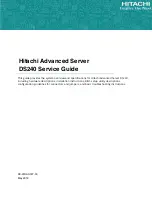Reviews:
No comments
Related manuals for AP140R-E1

BladeCenter HS23
Brand: IBM Pages: 28

WRR-5301
Brand: Hanwha Pages: 3

iDataPlex dx320 6385
Brand: IBM Pages: 60

DTS 4132.timeserver
Brand: Mobatime Pages: 108

R120d-1E N8100-1954F
Brand: NEC Pages: 166

SUPERSERVER 5017C-MF
Brand: Supero Pages: 96

NP301
Brand: 3onedata Pages: 3

NF5486M5
Brand: Inspur Pages: 2

HA800 Series
Brand: Hitachi Pages: 57

DS7000 Series
Brand: Hitachi Pages: 76

BladeSymphony 1000
Brand: Hitachi Pages: 52

DS7000 Series
Brand: Hitachi Pages: 91

DS240
Brand: Hitachi Pages: 174

HVM Navigator V03-06
Brand: Hitachi Pages: 312

NVM Navigator v03-07
Brand: Hitachi Pages: 316

4000
Brand: Hitachi Pages: 129

CB 520A A1
Brand: Hitachi Pages: 466

HUS VM
Brand: Hitachi Pages: 530

















